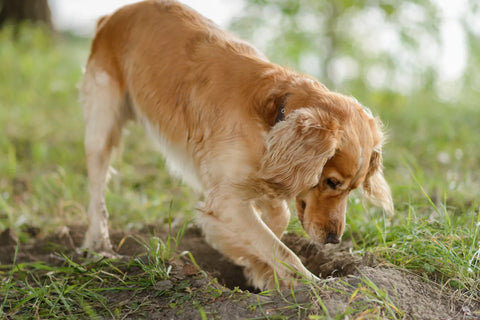
Can Dogs Eat Applesauce?
Ever catch your dog giving you those puppy-dog eyes while you’re enjoying a spoonful of applesauce? At A Pup Above, we know how hard it is to resist sharing snacks with your dog.
But before you dig out an extra spoon, let’s talk about whether applesauce is actually a good idea for your pup. Spoiler: it totally can be — with a few simple guidelines.
What Is Applesauce?
First things first, what exactly is applesauce anyway? It’s a simple, pureed mixture made from cooked apples, sometimes with added sugar, spices like cinnamon, or a splash of lemon juice. Think of it as a soft, spoonable version of one of the world’s most beloved fruits.
Applesauce has been around for centuries — originally, as a way to preserve apples before refrigeration was a thing. It’s still a pantry staple today, whether you’re enjoying it as a snack, baking with it, or serving it as a side dish. While some varieties come pre-packaged and sweetened, others stick to the basics with just apples and water.
Can Dogs Eat Applesauce?
So, can your dog nosh on the sauce? The short answer is yes — dogs can eat applesauce, but it depends on the type. Plain, unsweetened applesauce made from just apples and water is generally safe for dogs in moderation.
It’s a simple, easy-to-digest option that can make for a fun little treat — with some considerations.
Sweetened or Cinnamon Applesauce
Do you remember how we mentioned some varieties are sweetened or jazzed up with cinnamon? Well, here’s the scoop: sweetened applesauce often contains added sugars that aren’t good for dogs.
While sugar won’t necessarily harm them in small doses, it’s definitely not doing their waistline — or their teeth — any favors.
And then there’s cinnamon. While a sprinkle of this spice in plain applesauce isn’t toxic to dogs, too much can irritate their mouths or digestive systems. Plus, many cinnamon-flavored applesauce types are loaded with extra sugar or artificial flavoring.
The biggest no-no? Applesauce containing xylitol, a common artificial sweetener that’s toxic to dogs. Always check the label before sharing. When in doubt, stick to plain, unsweetened applesauce — or better yet, make your own. That way, you know exactly what’s in it.
Benefits of Applesauce for Dogs
We’ve scoped out what applesauce is and touched on the do's and don'ts, but let's dig into why this simple treat might just be a hit with your pup. When chosen carefully and given in moderation, applesauce isn't just tasty — it comes with a handful of perks for your pup’s health.
Tasty and Low-Calorie
Dogs have a sweet tooth just like us, and applesauce hits the spot without the baggage of extra calories found in many commercial dog treats. It's a great way to indulge their cravings for something sweet without overdoing it, especially if you stick to unsweetened, pure applesauce.
Stomach Friendly
Got a pup with a sensitive belly or one that’s bouncing back from a rough day? The smooth, soft texture of applesauce can be soothing for dogs with digestive issues. The fiber in apples also helps keep their digestion on track — just enough to help without causing trouble.
Helps With Hydration
Applesauce is sneaky good at boosting hydration thanks to its high water content. It’s a refreshing pick-me-up that’s particularly useful during summer or for the pup that isn’t keen on drinking enough water.
Nutritional Boost
While dogs naturally produce vitamin C, a little extra from applesauce doesn’t hurt. It’s good for their immune system and keeps their skin and coat looking sharp. Plus, applesauce comes with a sprinkle of other vitamins and minerals, supporting their overall health.
Super Easy To Serve
Whether you're mixing it into their kibble, using it as a smooth spoonful during training, or giving a gentle treat to an older dog with dental issues, applesauce is as easy to serve as it gets. It’s fuss-free, mess-free, and stress-free — exactly how snack time should be.
How Much Applesauce Can I Feed My Dog?
You’ve seen how applesauce can perk up your pup’s day, and you’re ready to pop open a jar — how much should you actually spoon out? Think of it as a little dab of delight, not a main dish. A couple of tablespoons a few times a week should hit the sweet spot, especially if it’s plain and unsweetened.
Remember, every dog’s digestion dances to its own beat, so start small to see how yours grooves with it. Too much of a good thing can turn the tummy tide, so if your dog seems off or their stomach gets funky, it might be a sign to dial it back. Keep it simple, keep it sparse, and, as always, keep an eye out for how your pup is feeling.
Applesauce vs. Apples for Dogs
By now, you know applesauce can be a dog-friendly treat, but how does it compare to the good ol’ crunch of a fresh apple? Applesauce is convenient, easy to eat, and great for dogs who can’t handle hard textures—like seniors or pups with dental issues. On the other hand, apples bring the crunch factor and can help clean teeth while giving your dog something to gnaw on.
But here’s the catch: apples need a little prep. You’ve got to ditch the core and seeds since they’re a no-go for dogs. Applesauce skips that hassle, but only if it’s plain and unsweetened — otherwise, you’re back to playing ingredient detective.
So, which is better? Honestly, it depends on your pup. If they love the crunch and you don’t mind slicing, go for apples. If convenience or soft snacks are more their vibe, applesauce wins the day.
How Do I Make Homemade Applesauce for Dogs?
If you’re all about knowing exactly what’s in your dog’s treats, consider making your own applesauce at home. It’s surprisingly simple and gives you complete control over the ingredients — no sneaky sugars, spices, or artificial stuff. Not to mention, it’s also a fun way to whip up something special for your pup.
Here’s how to do it:
Step 1: Pick Your Apples
Start with fresh, dog-safe apples like Fuji, Gala, or Honeycrisp. Avoid tart varieties like Granny Smith, which might be a bit intense for your pup’s taste buds. Wash them thoroughly to remove any dirt or residue.
Step 2: Prep the Apples
Peel, core, and chop the apples into small pieces. Remember, the core and seeds contain compounds that are harmful to dogs, so be extra careful to remove them entirely.
Step 3: Cook Them Down
Place the apple pieces in a pot with enough water to cover the bottom — about ½ cup should do. Bring it to a simmer and let the apples cook until they’re soft, usually around 10-15 minutes. Stir occasionally to prevent sticking.
Step 4: Mash or Blend
Once the apples are soft, let them cool for a few minutes. Then, mash them with a fork or potato masher for a chunkier texture, or toss them in a blender for a smoother sauce. Add a splash of water if needed to reach your desired consistency.
Step 5: Cool and Serve
Let the applesauce cool completely before serving it to your dog. You can store leftovers in an airtight container in the fridge for up to a week, or freeze portions for later. It’s a great treat to have on hand for snack time!
Conclusion
So, can dogs have applesauce? Yes, applesauce can be a safe and tasty treat for your pup when it’s plain, unsweetened, and served in moderation. Whether you’re scooping it straight from the jar or whipping up a homemade batch, it’s a simple way to mix things up for your dog.
Of course, if you’re looking for more than just treats, A Pup Above has you covered with our human-grade sous-vide meals. Try flavors like Texas Beef Stew or Turkey Pawella — packed with nutrition and taste. Because your dog deserves more than just good food — they deserve the best.
Sources:
Paws Off Xylitol; It's Dangerous for Dogs | FDA
Applesauce Recipe: How to Make Homemade Applesauce | MasterClass
A Matter of Taste: Why Dogs Love Sweets | The Animal Medical Center
Can Dogs Eat Apples? How to Safely Feed Apples to Dogs | American Kennel Club
Top Stories

Why Do Dogs Lick Their Paws?

Why Do Dogs Whimper & Make Noises in Their Sleep?

Healthy Vet-Approved Homemade Dog Food Recipes

How To Cook Sweet Potatoes for Dogs






















